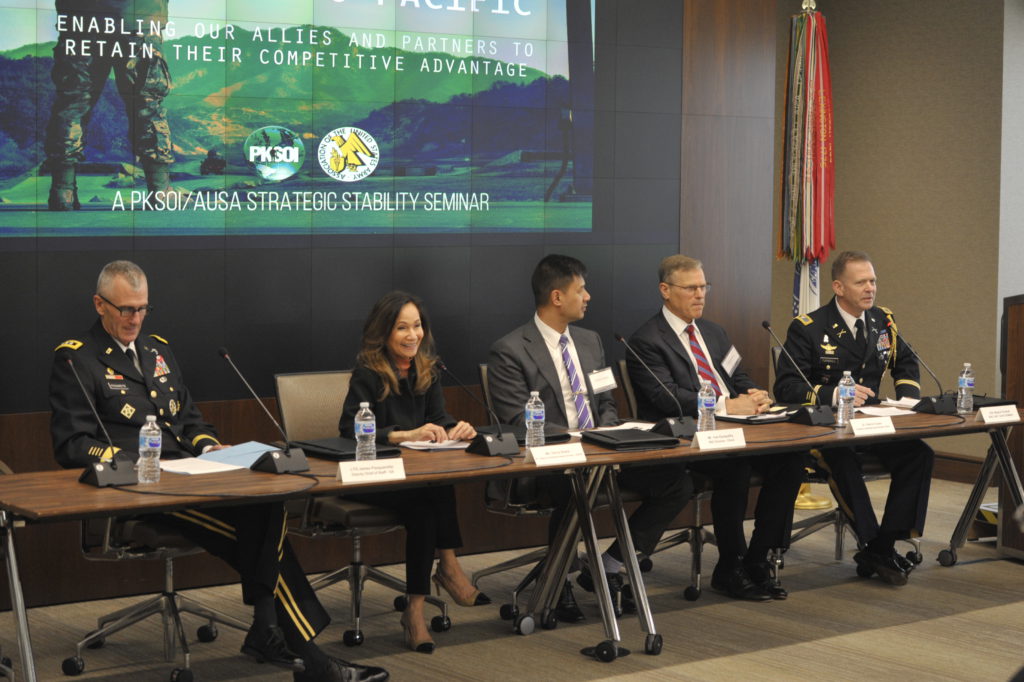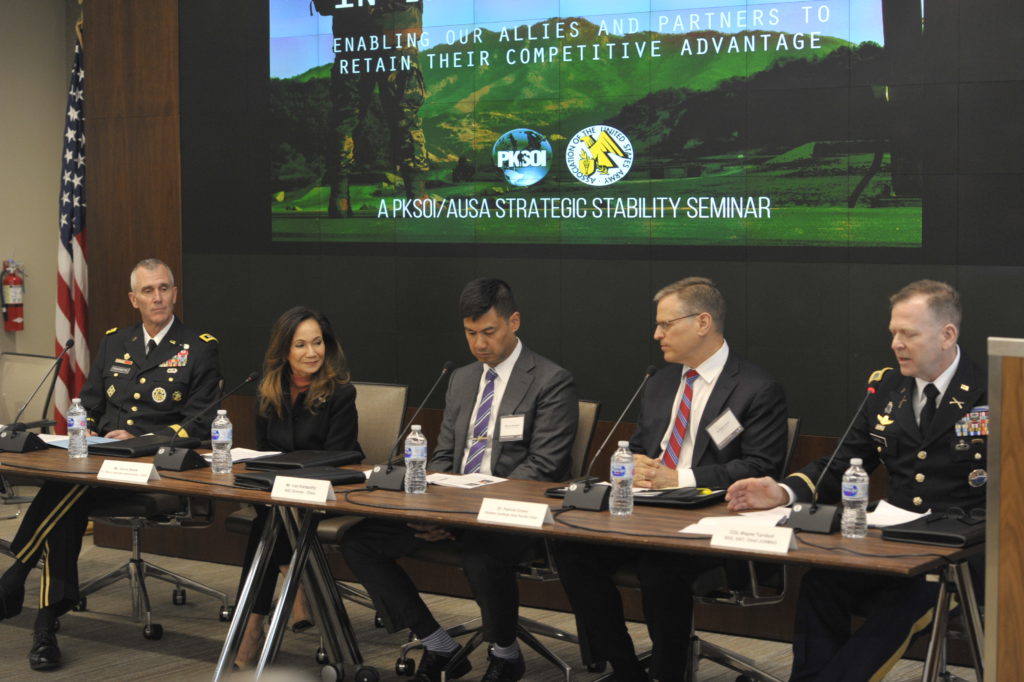Strategic Stability Seminar 2019

On September 19, 2019, the US Army’s Peacekeeping and Stability Operations Institute (PKSOI) and the Association of the United States Army (AUSA) hosted a one-day strategic seminar to discuss enhancing stability in the Indo-Pacific region by enabling our allies and partners to retain their competitive advantage. In its role as the Army’s lead for execution of joint proponency for Peace and Stability Operations, PKSOI, in co-sponsorship with AUSA, conducts an annual Strategic Stability Seminar bringing together senior military and government officials along with allied partners, non-governmental organizations, and academic institutions to discuss current challenges and best practices in stabilization. The purpose of this year’s seminar was to share ideas, concerns, and recommendations between industry experts, policy planners, and the community of interest, and to dig deeper into issues, probing potential solutions which are otherwise blocked by bureaucratic constructs. AUSA and PKSOI hosted the seminar at the AUSA conference center in Arlington, Virginia. What follows is a short description of key points and themes arising from the conference.
Opening Remarks: COL Scot Storey, Director, PKSOI; GEN(R) Carter Ham, President & CEO, AUSA, former Commanding General, USAFRICOM
Peacekeeping and stability missions remain as critical today as they were 26 years ago when GEN(R) Sullivan created PKSOI. The United States continues to have enduring interests in the Indo-Pacific region. While some U.S. departments and agencies still view the Indo-Pacific as an air- and sea-centric theater, stability in the region requires success in all domains.
Morning Key Note Speaker: Mr. Chad Sbragria, Deputy Assistant Secretary of Defense (DASD) for China

The United States faces many challenges in the Indo-Pacific region from authoritarian states, non-traditional threats, and rogue actors. China is the focus of U.S. efforts in the region. The United States seeks a free and open Indo-Pacific, governed by a rules-based international order and respect for the rule of law. The United States promotes state sovereignty, free from coercion, and open access to the global commons. China acts to undermine this vision, seeking to reshape the world to align with its authoritarian view. China does this by economically and politically intimidating other countries, contesting freedom of transit and commerce in the air and on the sea, threatening access to resources, exporting surveillance technology, and violating human rights domestically and abroad. Systemic competition is a Chinese concept designed to further its global interests. The Chinese have set specific milestones leading up to the 100th anniversary of the founding of the Chinese Communist Party. By 2035 they plan to complete military modernization. They plan to possess a “world class military” by 2049, capable of eroding U.S. military advantages and expanding sustained overseas Chinese presence.
China’s seizure of The Spratly Islands in the South China Sea is evidence of its willingness to threaten Taiwan, Malaysia, the Philippines, and Vietnam and to disregard international norms in pursuit of its vision. China continues to oppose cooperative freedom of navigation exercises. China is also funding and constructing overseas ports and seeks to establish military bases in Cambodia. It is expanding the reach of the Peoples Liberation Army (PLA) to match its economic interests through the promotion of the One Belt One Road Initiative (BRI). China continues to increase its presence in Africa, often under the guise of fulfilling United Nations missions. The PLA is future-oriented, working to improve its real-time command and control and precision strike capabilities by leveraging Artificial Intelligence technologies.
China actively steals trade secrets and intellectual property in areas such as aviation and anti-submarine warfare to aid Chinese industry. It also conducts numerous cyber campaigns to promote its agenda.
China resources non-violent projects in small states to increase their interdependence on China and facilitate their compliance with Chinese policy. China’s transactional approach encourages corruption and expects acquiescence to Chinese policy in exchange for aid.
China does not protect the privacy rights of its own citizens. It exports its control techniques, such as facial recognition software to other nations, to promote an authoritarian world view.
The United States is no longer in a period of overwhelming dominance and must now compete in the Indo-Pacific region with China to uphold freedom and openness. The fundamental Department of Defense (DOD) approach to the region has shifted. The Office of the Deputy Assistant Secretary of Defense for China specifically deals with China. Partnerships have renewed importance, including recent and ongoing activities with Japan, South Korea, Australia, Papua New Guinea, the Philippines, Thailand, Indonesia, Mongolia, Singapore, and India.
The U.S. whole-of-government approach to the Indo-Pacific region is well coordinated, to include close communication between the National Security Council, the Deputy Assistant Secretary of Defense (DASD) for Russia, and the Department of Homeland Security. There are no discrete, measurable “red lines” in competing with China. Rather, an aggregate, holistic understanding of Chinese aspirations and operations is necessary to compete successfully. This includes bringing U.S. European allies into the conversation. Further, strengthening Association of Southeast Asian Nations (ASEAN) connections must continue to dis-incentivize Chinese adventurism. Deepening interactions with partners is key, not just bilaterally, but multilaterally, emphasizing understanding, compatibility, and even interoperability. The approach must be holistic, including not just military, but diplomatic and economic efforts as well. The United States continues to present a resilient, consistent message to partners regarding the value of openness and a rules-based order to counter the transactional, manipulative approach of authoritarian China.
Panel Session 1: Free & Open Indo-Pacific
Moderator: COL Paul Turnbull, Senior Defense Official, Defense Attaché, and Chief of Joint United States Military Assistance Group (JUSMAG), Thailand
Panel Members: LTG Pasquarette, Deputy Chief of US Army Staff, G8; Ms. Gloria Steele, Senior Deputy Assistant Administrator, United States Agency for International Development (USAID); Mr. Kanapathy, National Security Council Director: China, Taiwan, and Mongolia; Dr. Patrick M. Cronin, Chair, Hudson Institute’s Asia-Pacific Security
Key Points:
- The United States used to believe that through constructive engagement, China would become more like the West. That approach has failed. China has recovered from the setbacks of the 20th century and now wants to change the status quo. China is an ancient nation that takes a long view of history. Time is on its side, and an autocratic approach allows a long-term focus.
- There are other challenges in the Indo-Pacific region besides China. Islamic extremism has spread there. The recent fighting in the Philippines was significant. North Korea continues to grow its global nuclear capability. Despite recent U.S. efforts, there has been no denuclearization progress. Russian aggressive activity in the vicinity of the Kirill Islands continues to grow. The Russian willingness to engage in military-to-military relations with China is disconcerting. Russia is a waning power, susceptible to rash action.
- The recent U.S. shift to the Indo-Pacific region is a recognition that future prosperity lies in the region. It was mostly a military pivot. The United States must now integrate a whole-of-government approach to be successful. The United States disappointed Japan by not following through on the Trans-Pacific Partnership. U.S. diplomatic efforts in the region are still not as focused as they should be. The U.S. government is unwieldy in regard to interagency cooperation. The United States does not take a long-term strategic view of the challenges. Democracy inherently has a short-term view, especially when compared to autocracies. China is an existential threat to the American way of life and requires a clearly resourced and supported grand strategy. The good news is the world is big enough for the both nations, but the United States must develop a long-term view to compete successfully.
- The U.S. footprint in the region is based on wars fought seventy years ago. It is not optimized for the problem set it faces today. Further, China would not be doing what it is doing today in the South China Sea if the United States had not abandoned its Philippine bases in 1991. The U.S. military must posture itself better in the region, especially in light of the Chinese focus on developing standoff technologies.
- The United States must be clear with allies what is expected. The United States cannot force nations to choose between it and China. Nations will act in their own best interests, and geographic proximity will force them to choose China. The United States must cultivate partners as a counterbalance to China.
- The U.S. interagency partnership experience in Mindanao, Philippines demonstrates that while each U.S. government agency has different goals, each is united by the National Security Strategy. For example, USAID and DOD’s Joint Special Operations Task Force (JSOTF) worked well together in 2015. The military presence provided USAID with a stable and secure environment for program implementation. And in turn, the implemented development programs addressed challenges that previously created a permissive environment for terrorist activities.
- China’s lack of transparency and corruption really undermine the U.S. strategy of maintaining a region that is free, open, and secure. The Philippines is a good example of this malign influence at work. Misinformation and lack of transparency helped President Rodrigo Duterte get elected. And because of the corruption in the Philippines, the private sector’s ability to compete has been challenged.
- The United States must impose costs on China for its malign activity. Information warfare is key to doing this. It is important to remember there are no “red lines;” The United States is already at war with China. The competition strategy acknowledges this. Further, judging by its actions rather than its words, China is not a partner in counterterrorism. The Uighur repatriation is the most recent example.
- The Chinese state-controlled economy is inefficient and will never be as value-added as the U.S. way of business. “Trade is dating, and investment is marriage.” U.S. and Japanese investment across the Indo-Pacific region is orders-of-magnitude greater than China’s. It is a demonstration of long-term commitment to U.S. partners.
- China pursues a political warfare strategy with gray zone campaigns, using all instruments short of war. China seeks to win without fighting through its technology-driven Belt and Road economic initiative, military and paramilitary influence, state propaganda, and legal and paralegal instruments. For example, China is coopting Duterte by saying, “Don’t listen to international agreements; let’s do this bilaterally and drop the rule of law approach.”
- The essence of Chinese competition is economic, especially until 2035, when it plans to shift to a military focus. It is centered on information dominance and a psychological warfare approach. China emphasizes that the United States is the destabilizing force in the region; the United States is in decline, and China is ascendant.
- The South China Sea is critical; it has abundant resources and is easiest for China to influence. The Chinese are waging political warfare now and are seeking to accelerate a U.S. withdrawal from the region.
- The United States must better understand Chinese actions and aspirations, and it must push back immediately with political warfare actions to prevent an intensification of hybrid war in Asia. Strategic dialogue with China is key to avoid inadvertent escalation. Further, the United States needs to do now what it should have done a decade ago: compete with China, not help it. Understanding that economic security is national security is important. The pivot to Indo-China is not just a shift from counterterrorism, but also a complete change in how the United States conducts conventional warfare. The United States’ current platform-centric power projection military will not enable this new approach. This current opportunity is exploitable because China is focused on conventional sea and air platforms. The United States can go in a different direction.
Extreme climate change events also affect U.S.-China competition. For example, the United States and China only really get along currently in extreme events response and peacekeeping opportunities. Further, China causes environmental harm through investment in ports and natural resource exploitation infrastructure. China also seeks to compete with the United States in how much it contributes to disaster relief. China’s participation in the illegal trafficking of wildlife is also problematic.
Afternoon Keynote Speaker: Mr. Thomas Vajda, DAS for India, Bangladesh, Nepal, Sri Lanka, Bhutan, and Maldives; Bureau of South and Central Asia Affairs

Dynamism in Indo-Pacific results from the popularity of American values and principles with many nations in the region, including India. These values are threatened by malign actors. The United States must broaden the prism it views relations with India through, from just “India-Pakistan” to India’s total role in the Indo-Pacific region, especially as a counter to China. The United States should operationalize India’s rise by helping it close security and defense capability gaps with China. The United States should pull India from a strategic autonomy posture towards habits of cooperation, especially with Japan and Australia. The United States should continue to move to a long-term partnership with India by building on patterns of cooperation, by conducting strategic conversations about India’s doctrine and strategy, and by operationalizing Indian counterterrorism capabilities. Further, the United States should co-fund and coordinate infrastructure projects in areas, such as cyber and maritime security, so as to counter Chinas’ Belt and Road Initiative (BRI).
Challenges to this strategic vision of cooperation with India include:
- India’s non-aligned movement heritage. It does not want to be dependent on any one country, including Iran, Russia, or China. It is unlikely it will ever be a U.S. treaty ally, like the United States has with Australia.
- Trade. The United States has a large trade deficit with India. Further, India is dependent on Russian military equipment. It is diversifying with U.S. equipment, but still wants Russian S400 missiles and nuclear submarines. The United States compelled India to stop Iranian oil imports in May, 2019, which also complicates U.S.-India relations.
- Kashmir. A heavy-handed Indian effort to crack down on Kashmiris calls into question India’s commitment to human rights.
Factors facilitating closer U.S.-Indian relations include:
- India’s self-perception as a civilizational power with deep roots in history that needs U.S. assistance to achieve its current aspirations.
- Strong U.S.-India human-to-human relations. Four million Indians currently reside in the United States.
India’s shared border with Afghanistan, Pakistan, and China also heavily influences its policy in the Indo-Pacific region. India currently provides much economic assistance to Afghanistan, but it is wary of the Taliban gaining a large government role and promoting groups that want to attack Indians. The United States has moved more to viewing India and Pakistan as regional actors in their own right, cultivating Indian relations in a more independent manner. Recent concerns between India and China over the Doklam Plateau have motivated both sides to seek a de-escalation of friction. Both sides are being careful, scheduling informal summit meetings and a Xi visit to India next month. India’s goal is to close vulnerability gaps in Doklam that may invite Chinese adventurism.
Panel Session 2: Actors & Threats
Moderator: Dr. Rich Love, Assistant Director, and Professor of Stabilization and Peace Operations, Peacekeeping and Stability Operations Institute
Panel Members: BG ‘JB’ Vowell, Deputy Director Strategic Planning and Policy, USINDO-PACOM; Ms. Kristen Gunness, Chief Executive Officer of Vantage Point Asia; Mr. Harry Nahatis, Vice President and General Manager, Turboshaft Engines and Military Systems, GE Aviation
Key Points:
- Competition with China is not “Cold War 2.0.” For example, the U.S. and Chinese economies are much intertwined. The Soviet and U.S. economies were not. However, China is challenging the current international system by attempting to reshape norms to be more beneficial to Beijing. The United States has many allies in preventing this, while China has few.
- China’s Belt and Road Initiative (BRI) seeks to build global influence and create a more secure environment for China by diversifying energy and transportation routes. It strives to increase regional reliance on China through political and economic means, particularly in the technology and space sectors through the BRI Space Information Corridor. This features applications related to navigation and positioning, remote sensing, weather, and communications satellites, and the BRI Digital Silk Road, which focuses on the development of communications networks, smart cities, and e-commerce activities. BRI will expand China’s military footprint worldwide, as the PLA develops increased expeditionary capabilities to protect BRI investments and People’s Republic of China (PRC) citizens living overseas. Inter-regional competition will also increase, as the PLA expands its presence to places, like the Indian Ocean, through dual civilian-military use port agreements.
- The United States should not compete with the BRI symmetrically, but rather leverage the access provided by Western open-market and rule-of-law values. Opportunities also exist to increase U.S. influence in areas where a growing PLA footprint to secure the BRI is not welcomed by the local population.
- The Indo-Pacific’s vast distances and widely varying levels of technology and political stability dictate that industry develop products that are reliable, can operate across long ranges, and leverage modular designs that can be fixed forward in austere environments. 3-D printing is a game-changing technology that particularly facilitates industry success in the region.
- The Chinese-North Korean relationship is very complex. China views North Korea as a buffer state. China does not want instability in North Korea that could bleed into China, and it is concerned about North Korean refugees flooding across the border should instability arise. It is more difficult than most people think to leverage North Korea through China. For example, Chinese provinces have quotas and economic authority to raise money that the central government does not control.
- Recent cooperation between Russia and China is not about interoperability, but a strategic messaging opportunity designed to disrupt U.S. influence in the Indo-Pacific region. Sino-Russian relations have a long history of mistrust, and this mistrust could create tensions between the two countries in the future. For example, what happens when China becomes more involved in former USSR Central Asian states that Putin sees as within Russia’s sphere of influence? That said, Sino-Russian cooperation is a cause for concern, and the United States should not do anything to accelerate the relationship.
- Hong Kong is currently a flashpoint in the Indo-Pacific region and a bell weather for China’s stated goal of reunification with Taiwan through the “One Country, Two Systems” rubric. The recent protests effectively mark the death of the “One Country, Two Systems” relationship between China and Hong Kong. China will not let this kind of unrest happen again and will likely increase surveillance and restrictions in the future, especially on foreign nationals and businesses, an important consideration given the 103,000 U.S. citizens living in Hong Kong.
- Internally, China continues to face challenges. The One Child policy has resulted in demographic weaknesses, as the aging population has not been sufficiently replaced by a large enough younger generation. However, the Chinese government has long been aware of this issue and has countered it with automation and urbanization. A growing middle class has supplanted the peasant class, and this has raised personal livelihoods, which helps counter the effects of an aging population. China is also considering immigration as a strategy to avoid a slowdown in growth from an aging population.
Panel Session 3: Partnerships for Resiliency
Moderator: Professor Charles E. Bennett, DOS, USAWC Professor, and Former Consul General
Panel Members: Ms. Cara Abercrombie, Principal Director, Defense Security Cooperation Agency; BG Tan Boon Kim, Defense Attaché at the Embassy of Singapore in Washington, DC; BG Zachary F. Doser, Commander, Land Component Command, Nevada Army National Guard; Dr. Elizabeth Kunce-Wagner, Associate Professor, Center for Excellence in Disaster Management and Humanitarian Assistance; MG Yoshiki Adachi Defense Attaché at the Embassy of Japan in Washington, DC
Key Points:
- The U.S. comparative strength in the region is alliances and partnerships. The United States supports partner militaries with arms and equipment, and it promotes access through cooperative exercises. The U.S. approach is not as transactional as other nations, and it places a long-term emphasis on transparency and human rights. The United States increasingly focuses on interoperability, based on training, doctrine, planning and institutional capacity development. The United States is building new relationships with Vietnam, Bangladesh, and Malaysia, and it continues a strong partnership work with Japan, India, and South Korea. The United States is now emphasizing multilateral relationships and networking partners together. Close allies are now cooperating together without the United States in pursuit of common goals. U.S. allies and partners are increasing empowered to work together across the Indo-Pacific region.
- The Indo-Pacific region perceives the U.S. post-World War Two presence as a “breadth of spirit and generosity.” The United States can leverage this perception to enhance regional resiliency by:
- Capitalizing on the perception of the United States as a benign power. The United States enabled non-communist countries to resist communism. Cooperation with the United States is based on a fundamental alignment of interests and values, not transactional principles. The United States underwrites an open, rules-based order that benefits the entire Indo-Pacific region.
- Continuing to strengthen bilateral relationships to promote the multilateral success of ASEAN.
- Being consistent. The United States should continue to maintain the rules-based order in the region and demonstrate it is a reliable partner over the long run and across administrations.
- Going beyond defense. Trade and commerce links must spread along with an INDOPACOM presence. Economic leadership is also key. The United States should increase emphasis on people-to-people links to enhance soft power.
- The DOD State Partnership Program (SPP) is a Whole of Government approach to strengthening access and resiliency with important partners in the Indo-Pacific region. The SPP leverages National Guard strengths in areas, such as Humanitarian Assistance and Disaster Relief (HADR), combatting trans-national narcotic trafficking, emergency management, combatting gang violence and water management to provide no-strings-attached assistance to help partner nations help themselves.
- Japan’s vision for the Indo-Pacific region is to promote the rule of law and free trade, the pursuit of economic prosperity, and the commitment to peace and stability through an interconnected Africa, Asia, Indian Ocean and Pacific Ocean. Japan currently supports capacity building through these interconnected spheres by funding United Nations projects in Kenya, Vietnam, and Uganda.


